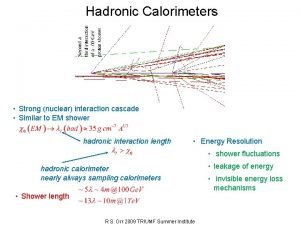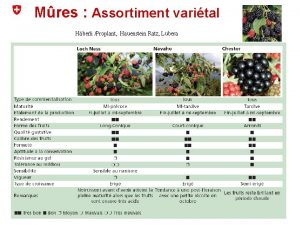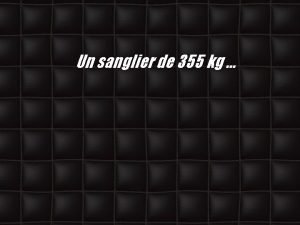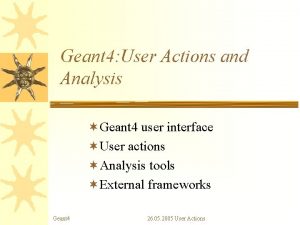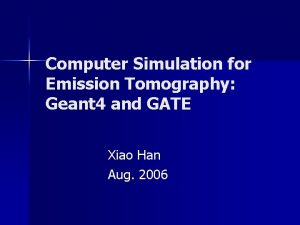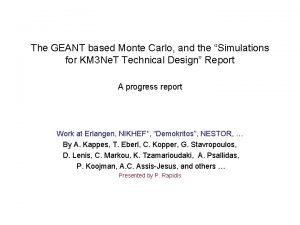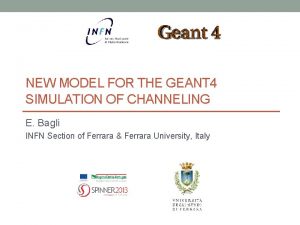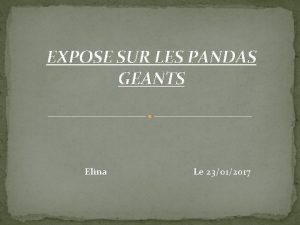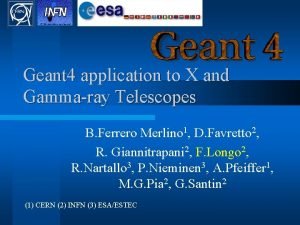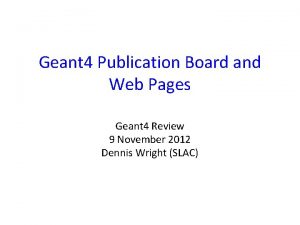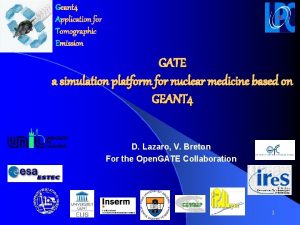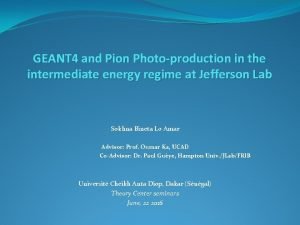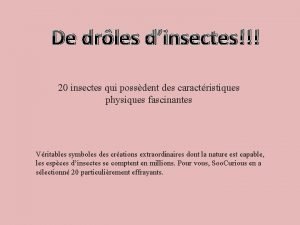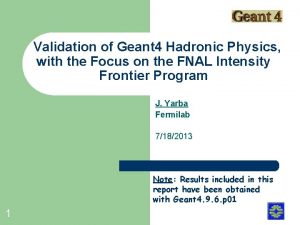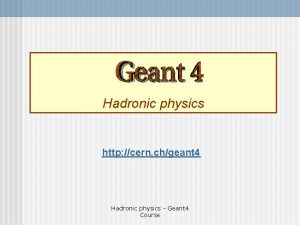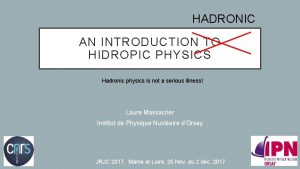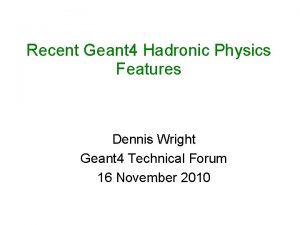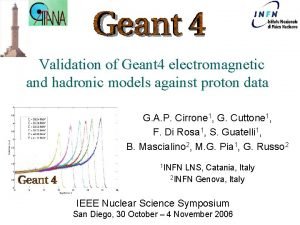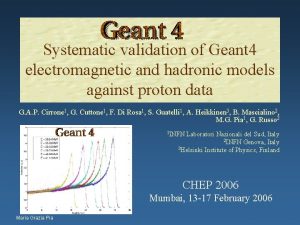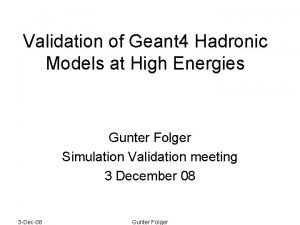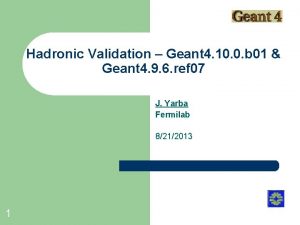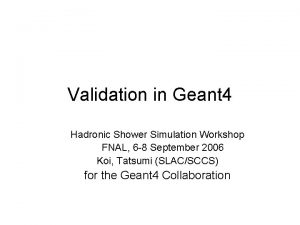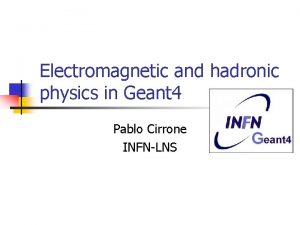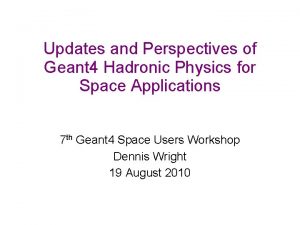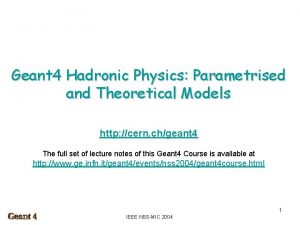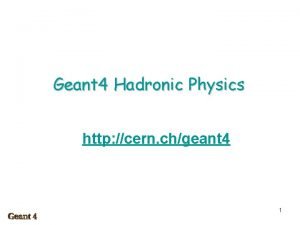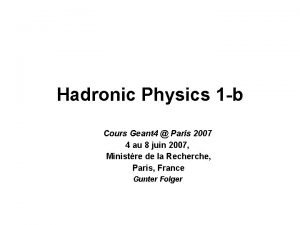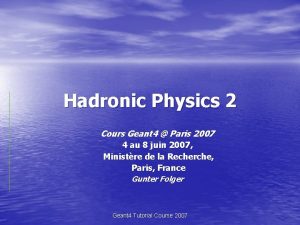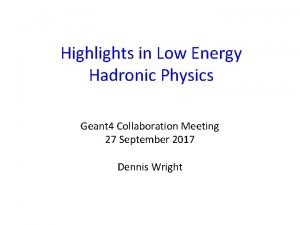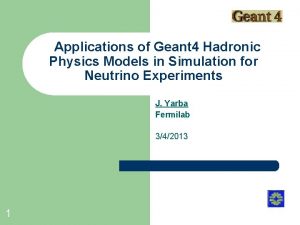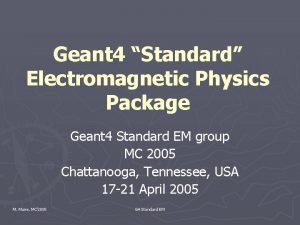Geant 4 Hadronic Physics Performance Recent Validation and

































- Slides: 33

Geant 4 Hadronic Physics Performance: Recent Validation and Developments J. M. Quesada (on behalf of the Geant 4 Hadronic Working Group) Geant 4 Users and Collaboration Workshop 15 October 2009

Outline • Performance Issues • Key Validation Results • Successes and Challenges • Key Developments • Summary 2

Performance Issues • Physics performance: agreement of model predictions with data • validation • accesibility • Computing performance • CPU Speed: cost per interaction improved by code review • Efficiency use of memory (allocations per interaction) • Goal to improve a model with no change in physics. • Code usability – docs, guidelines – modularity – ease of use 3

Validation Efforts and Accessibility • Our goal is to provide extensive validation of every active Geant 4 hadronic model and cross section set • Against thin-target data (primarily) • And make the results easily accessible to users • Most results are regenerated with each major Geant 4 release and are linked to the Geant 4 web page • During the past two years much effort has been devoted to improving Geant 4 hadronic validation – according to the January 2009 Review of the Geant 4 project: “An impressive program of systematic physics validation has been carried out. ” 4

Survey of Validation Efforts (1) • Stopped particles – M. Kossov (CERN), J. Yarba (FNAL) – -, K-, anti-p – geant 4. cern. ch/results/validation_plots/thin_target/hadr onic/stopped • Heavy ions – P. Cirrone, F. Romano, G. Cuttone (INFN, Catania) – T. Koi (SLAC) – E < 10 Ge. V/N – target: 12 < A < 208, projectile: 12 < A < 56 – web pages under construction 5

Nucleus-nucleus model validation Catania group (LNS-INFN) is involved on nucleus-nucleus models validation at intermediatelow energy (10 -400 Me. V/n). This energy range is of interest for medical applications, in which the group is involved on (hadrontherapy). § Binary Light Ion Cascade Nucleus-nucleus interaction § Quantum Molecular Dynamics (QMD) models available in Geant 4: § Abrasion Ablation § G 4 QLow. Energy few experimental data published for thin targets at low energy! (most of them secondary neutron production) C+C n+X incident beams: targets: He, C, Ne, Ar C, Al, Cu, Pb Comparison of experimental neutron double differential cross sections production at different angles and those predicted by different models Reference: H. Sato et al. , Measurements of double differential neutron production cross sections by 135 AMe. V He, C, Ne, and 95 AMe. V Ar ions Phys. Rev. C, 64, 054607 (2001)

Nucleus-nucleus models validation (cont. ) Experiment at LNS-INFN in Catania for fragments production 12 C + 197 Au @ 62 Me. V/n p, d, t, 3 He, α, 6 He, 6 Li, 7 Be, 9 Be, 10 B, 11 B , 11 C Experimental apparatus: Two hodoscopes with different granularity (“Hodo big” and “Hodo small”) composed by ΔE-E telescope detectors, able to identify the different isotopes detected. Double differential cross sections for charged fragments production have been compared C + Au p + X Hodo big 12 C beam Scheme of the experimental apparatus Hodo small Future plan • Measurements at low energy (C + C @ 62 Me. V/n) already performed at LNS Catania in April 2009 (analysis still in progress) • New measurements at higher energy at GSI (Germany) approved for 2010 • Intercomparison with other Monte Carlo codes (Fluka)

Nucleus-nucleus: G 4 QMD vs data “Energy deposition in intermediate-energy nucleon–nucleus collisions, ” Kwiatkowski et al. , Phys. Rev. Lett. , vol. 50, no. 21, pp. 1648– 1651, 1983 This result includes some but not all recent corrections.

Survey of Validation Efforts (2) • Cascade energy – p, n on various targets, 20 Me. V – 3 Ge. V (labelled test 30) – cern. ch/vnivanch/tests. shtml (V. Ivanchenko, A. Ivanchenko - CERN) • Transition region – p on various targets, 3 -12 Ge. V (labelled test 35) – cern. ch/vnivanch/tests. shtml (V. Ivanchenko, A. Ivanchenko - CERN) – proton and pion double-differential cross sections for various targets – Covers 100 Me. V – 20 Ge. V – geant 4. fnal. gov/hadronic_validation/validation_plots/thin_target /hadronic/medium_energy/index 1. shtml – S. Banerjee, J. Yarba, D. Elvira (FNAL) 9

Survey of Validation Efforts (3) • High(est) energy – 100 – 400 Ge. V protons, pions on various nuclei • geant 4. fnal. gov/hadronic_validation/validation_plots/thin_targe t/hadronic/high_energy – G. Folger • CHIPS – test 49 – M. Kossov 10

CPU performance • Speed: efforts to improve it as LHC running approaches • Memory use: addressing problems reported by ATLAS (memory churn = allocate+free in 1 step) Code usability • Documentation: a task force is working on improving documentation of physics lists and model usage. • Easy of use: we continue to be concerned with improving ease of use of hadronic models.

IAEA benchmark of spallation data • The benchmark includes nucleon-induced reactions on nuclei from carbon to uranium • Energy range: 20 Me. V to 3 Ge. V • Geant 4 has participated in benchmarking • In parallel with intensive model improvement, • This benchmarking has triggered a series of critical model improvements • in pre-compound & de-excitation models in Geant 4

Light cluster emission: improvement Pb (p, d) at 63 Me. V BEFORE NOW 9. 2 p 01 9. 2 E(Me. V)

Light cluster emission BEFORE 9. 2

Light cluster emission BEFORE 9. 2 NOW 9. 2 p 01

Isotope production at 1000 Me. V in inverse kinematics BEFORE 9. 2 p 01 NOW 9. 3 Includes GEM (corrected)

Progress (1) • IAEA spallation validation exercise – was very helpful in identifying and fixing problems with G 4 Precompound, Binary and Bertini cascade models • improved low energy behavior (< 200 Me. V) • Shower shapes – improved treatment of quasi-elastic scattering in nuclei has solved most problems with shower shapes • Comparison with other codes – A measure of progress in this area • Some Geant 4 hadronics members becoming Fluka users and learning to use code; • Preliminary comparisons with Dubna Cascade, Ur. QMD. 17

Progress (2) • Model transition region – we now have a much better understanding of what is going on in the energy regions between models in a physics list • simplified calorimeter studies of energy partition among particle types – we are beginning to understand how to extend cascade models higher in energy, string models lower in energy • using Binary, Bertini and CHIPS models as “back-ends” for string models • shutting off Bertini cascade at high energies • => will allow the removal of the energy non-conserving LEP models from some physics lists 18

Validation with CMS TB Data Test done with Geant 4 9. 3. beta 01 for 3 physics lists: QGSP_BERT, QGSP_BERT_EMV, QGSP_FTFP_BERT CMS measured response of the combined calorimeter with identified pion and proton beams of momenta between 2 and 350 Ge. V/c Measures mean response and resolutions separately with all events and MIP like signal in the ECAL Also measures the fraction of MIP events as a function of beam energy

Challenges (1) • Energy non-conservation in some physics lists – LEP, HEP models used in cases where no other physics list applies • these models do not conserve energy – even on average • Model transition region – discontinuities as one moves in energy from one model domain to another • multiplicity • mean energy per particle type • angular distributions – energy response & resolution affected • important for calibration, jets, energy scale – For LHC and ILC calorimeters 20

Model transition region Energy response in a simplified Cu -LAr calorimeter QGSP_BERT uses (in Ge. V) • Bertini: 0 -9. 9 • LEP: 9. 5 -25 • QGS/P: 12+ 21

Origin of the problem Energy fractions of secondaries produced in π- Fe inelastic interactions p all π0 22

Challenges (2) • Low energy behaviour – Incident p and n below 200 Me. V • large differences between models in number of these particles predicted • more work required on low energy end of cascade and nuclear physics • New aspects important for ILC calorimeter – High granularity requires good lateral profile, . . • Comparison with other codes (MCNP, Fluka, . . . ) – has been a challenge in the past • few people expert in more than one code => difficult to do comparisons • not many opportunities for head-to-head comparisons 23

24

Developments in Bertini Cascade • Coulomb barrier added in cascade and precompound phases • Completed review and correction of total and partial cross sections used in intra-nuclear cascade – nucleon-nucleon, pion-nucleon – 95 cross sections reviewed from 0 to 30 Ge. V • Added partial cross sections for production of strange particle pairs from p-p and -p interactions – K, KK • Investigating “shutting off” cascade at energies above 3 Ge. V – using trailing effect, formation length 25

Corrected Bertini Cross Sections: - p -> 2 body, before and after Old=9. 3 beta New= recent development 26

FTF: The FRITIOF Model Implementation in Geant 4 § Alternative string model starting at ~3 Ge. V § Potential to improve transitions § Can be coupled with the Binary model (= FTF_BIC) § provides a smoother transition to cascade models in the most problematic energy region (3 -20 Ge. V) § (Simple transition from Bertini to FTF still has bump 3 -5 Ge. V) § Key model details: § Hadron-hadron interactions are modelled as binary reactions § Multiple collisions are calculated in Glauber approach § including elastic re-scatterings of hadrons. § Excited states are considered as QCD-strings § the LUND model is used for their fragmentation.

The FRITIOF Model: validation & tuning Latest tuning

Model improvements in pre-equilibrium and de-excitation models • Fixed errors in pre-equilibrium • in the widths of light cluster emission • Fixed errors in equilibrium de-excitation • fission widths • excitation energies of fragments in Fermi Break-Up. • emission widths in Generalized Evaporation Model (GEM). • Tuned parameters of fission. • New “hybrid “ model : • Weisskopf-Ewing for n, p, d, t, 3 He, 4 He • GEM for heavier ejectiles (A<29, Z<13).

Improvements in G 4 QMD • Improved nuclear fragment creation • Using detailed GEM de-excitation model (via physics list) – Default is now G 4 GEM • Option of FRAG mode in cascade phase in order to obtain best fragment production – Default is OFF, i. e. optimized for energy spectra of secondary nucleons • Corrected meson absorption in reaction phase – Used to break (E, p) conservation at high energy – Corrected in V 9. 2 patch 2. • Extended for use in additional reactions – proton, neutron and pion incident • Used first corrections of GEM 30



SUMMARY • Systematic validation effort carried out. • Extensions undertaken and ongoing. • Deficiencies due to transitions between model • Found and being investigated • Different approaches to address them are underway. • Model improvements being carried out • Fixes made and retuning of some models • Further improvements under way. • Thin target comparisons are benchmarks for models • Thick target, e. g. calorimeter studies used to confirm • New challenge(s) • Next generation (high granularity) calorimeter data (CALICE)
 Hadronic
Hadronic Hadronic cascade
Hadronic cascade Appraisal time management
Appraisal time management Myrtillier géant
Myrtillier géant Renmap
Renmap Sanglier turquie
Sanglier turquie Biggest bulldozer
Biggest bulldozer Action geant
Action geant Geant computer
Geant computer Geant simulation
Geant simulation Geant 4
Geant 4 Le géant atlas dans son café de bonsecours
Le géant atlas dans son café de bonsecours Exposé sur le panda géant
Exposé sur le panda géant Geant 4
Geant 4 Geant 4
Geant 4 Pub geant
Pub geant Gate geant
Gate geant Pion geant
Pion geant Blatte rhinocéros
Blatte rhinocéros Recent trends in ic engine
Recent trends in ic engine Recent developments in ict
Recent developments in ict Recent developments in object detection
Recent developments in object detection Is college worth it synthesis essay
Is college worth it synthesis essay Modern trends of foreign trade in india
Modern trends of foreign trade in india Skimming and scanning examples
Skimming and scanning examples Modern trends in project management
Modern trends in project management Recent demographic changes in the uk
Recent demographic changes in the uk Schoology myips
Schoology myips Stippling
Stippling After miguel's recent automobile accident
After miguel's recent automobile accident A friend emails you the results of a recent high school
A friend emails you the results of a recent high school Recent advances in ceramics
Recent advances in ceramics Recent news in passive voice
Recent news in passive voice Http drive google com
Http drive google com

